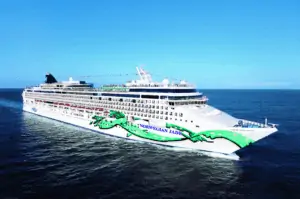Cruise news stories are prone to errors, especially norovirus outbreaks. Given the frequency of the topic and the rapid spread of misinformation in the digital age, it is important to correct the record.
What is Norovirus?

Norovirus is a very contagious virus that causes vomiting and diarrhea. It is the primary cause of acute gastroenteritis in the United States, commonly known as the stomach flu. Norovirus can spread through various means, including contact with contaminated food, water, or surfaces and through person-to-person contact.
The CDC puts it bluntly when they explain how norovirus is spread.
“You can get norovirus by accidentally getting tiny particles of feces (poop) or vomit in your mouth from a person infected with norovirus. If you get norovirus illness, you can shed billions of norovirus particles that you can’t see without a microscope. It only takes a few norovirus particles to make you and other people sick.”
Norovirus by the Numbers

The latest numbers from the CDC show that 19 to 21 million cases of norovirus are reported worldwide. That number alone should indicate how common it is and that it is far more likely to be something you deal with on dry land than on a cruise ship.
| LOCATION | 2023 CASES |
|---|---|
| Cruise | 2,017 cases (CDC DATA) |
| Land | 19-21 million cases (CDC DATA) |
It’s More than a “Cruise Ship” Thing

While some people, especially journalists more interested in buzz-worthy headlines than facts, report on outbreaks aboard cruise ships as if they were the bug’s primary breeding ground. This is far from the truth.
Health officials record illnesses on board ships and declare an outbreak once several passengers have fallen ill. The incubation period of the virus after coming into contact is typically between 12 and 48 hours.
This means that if you fall ill at the beginning of a cruise, you will still be on the ship when you fall ill but likely pass it on to at least a few other people.
The CDC reporting threshold is if two percent of guests and crew members on a cruise ship become sick or three percent of the vessel’s guests.

The cruise line is required to report the outbreak to the CDC, and the next thing you know, there’s yet another headline about an outbreak on a cruise ship.
If you contract the bug while on a plane, you will get just as sick and are likely to spread the infection to as many people as you would on a cruise ship, but due to the open environment of a plane, such incidents are not usually reported.
Similarly, if you come into contact with it at an amusement park, there’s a good chance that you won’t even realize what it is, thinking instead that you’ve got a bad case of food poisoning.
Keeping Yourself Safe from Norovirus

Yes. People catch it on ships, but the incidence rate is lower than on dry land. However, outbreaks on land usually go unnoticed due to the setting. Once the virus hits a ship, it can easily spread because of its contagious nature.
Here are some tips:
- Wash your hands for 20 seconds or longer with warm soapy water
- Leave the area if you see someone getting sick
- Don’t wear yourself down.
- Get rest and stay hydrated to keep your immune system strong.
- At the first sign of illness, go to the ship’s infirmary. They won’t charge you because they don’t want the ship infected.
- Avoid touching the railings on stairs or elevator buttons. Try to take the stairs.
- Pack hand sanitizer to use before touching your food at the buffet.
- Use the antibacterial stations on the ship.
Featured photo: Norovirus cells via theherbalcache.com
Pin this!








![First Time Cruise to Europe + Cruise News [Podcast]](jpg/1681310099-msc-world-europa-maiden-call-genoa-italy-1-300x206.jpg)
